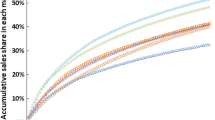Abstract
Background
Japan is currently the second largest pharmaceutical market in the world, and Japanese pharmaceutical companies are actively seeking to identify assets in other countries. An affluent population provides ample opportunity for pharmaceutical companies to develop within Japan; however, given its weak macroeconomic foundation, Japan is currently seeking to cut costs through the use of more generic drugs and lower prices. Nevertheless, no detailed empirical analyses regarding how Japanese companies can expand their global presence while ensuring domestic sales, or what opportunities lie ahead for global companies planning to enter the Japanese market, have been conducted. To our knowledge, this is the first study to provide statistical evidence regarding characteristics of the Japanese market.
Methods
The data set for this study was the most recent list of the 100 top-selling drugs globally and in Japan, the United States, the United Kingdom, France, and Germany. The data were obtained from the IMS Japan Pharmaceutical Market database.
Results
More cardiovascular and less central nervous system (CNS) and oncology drugs were ranked among the top 100 best-selling drugs in the Japanese market; however, the promotion of CNS and oncology drug development was evident, and competition from generic drugs was shown to have eroded, especially in therapeutic areas with no assured benefits in the global market, such as with cardiovascular drugs.
Conclusions
These results suggest that the Japanese market will rival overseas markets in the near future. Pharmaceutical companies should seriously consider operating within Japan, whose market is currently transitioning to a global market.
Similar content being viewed by others
References
Glenn Thomas Lacy. Are we all global now? Local vs. foreign sources of corporate competence: the case of the Japanese pharmaceutical industry. Strategic Manage J. 2004:25:865–886.
Shibata S, Uemura R, Suzuki T. Factors that affect acquisition of reward premiums for promotion of innovative drug discovery in Japan. Ther Innov Regul Sci. (in press)
Cegedim Strategic Data K.K. Global Pharmaceuticals Sales Ranking in 2013. June 2014. Osaka, Japan: Cegedim Strategic Data K.K.
Riku J. Current situation for generic drugs in Japan. J Generic Med. 2005;2:219–231.
Shimura H, Masuda S, Kimura H. Analyzing the generic penetration trend in the Japanese dispensing market by therapeutic category. J Generic Med. 2012;9:55–62.
Chabner BA. Drug shortages—a critical challenge for the generic-drug market. N Engl J Med. 2011;365:2147–2149.
Dickson M, Gagnon JP. The cost of new drug discovery and development. Discov Med. 2009;4:172–179.
DiMasi JA, Feldman L, Seckler A, Wilson A. Trends in risks associated with new drug development: success rates for investigational drugs. Clin Pharmacol Ther. 2010;87:272–277.
Kola I. The state of innovation in drug development. Clin Pharmacol Ther. 2008:83:227–230.
Kola I, Landis J. Can the pharmaceutical industry reduce attrition rates? Nat Rev Drug Discov. 2004;3:711–716.
LaMattina JL. The impact of mergers on pharmaceutical R&D. Nat Rev Drug Discov. 2011;10:559–560.
Barnes JJ, Cohen R, Cardoo EJ. Microcosms in aquatic ecosystem research. In: Hemingway E, ed. Pollution and Aquatic Ecosystems. Springfield, VA: National Technical Information Service; 1986:24–39.
Getz KA, Wenger J, Campo RA, Seguine ES, Kaitin K. Assessing the impact of protocol design changes on clinical trial performance. Am J Ther. 2008;15:450–457.
IMS Health Inc. IMS Health Market Prognosis, June 2013. Danbury, CT: IMS Health Inc.
Umemura M, Fujioka R. Comparative responses to globalization experiences of British and Japanese Enterprises. New York: Palgrave Macmillan; 2013.
IMS Health Inc. MAT pharmaceutical market statistical analysis in 2014. Danbury, CT: IMS Health Inc.
Takaku F, Yazaki Y. Manual of Therapeutic Agents 2014. Tokyo, Japan: Igaku-Shoin Ltd; 2014.
Braun MM, Farag-El-Massah S, Xu K, Coté TR. Emergence of orphan drugs in the United States: a quantitative assessment of the first 25 years. Nat Rev. 2010;9:519–522.
Miller BA, Chu KC, Hankey BF, Ries LAG. Cancer incidence and mortality patterns among specific Asian and Pacific Islander populations in the US. Cancer Causes Control. 2008;19:227–256.
Shibata S, Uemura R, Suzuki T. Impact of premium rewards for the promotion of innovative drug discovery on the Japanese pharmaceutical market: an analysis by therapeutic area. Therap Innovation Regul Sci. (in press)
World Health Organization. Asia Pacific strategy for emerging diseases (2005).
Lansang MA, Alejandra M, Banzon E, Castillo-Carandang N, Juban N. A rapid situational analysis of health policy and systems research in the Western Pacific region. World Health Organization, Western Pacific Regional Office, 2006.
Author information
Authors and Affiliations
Corresponding author
Rights and permissions
About this article
Cite this article
Shibata, S., Uemura, R. & Suzuki, T. Comparative Analysis Between the Top-Selling Drugs in the Japanese Pharmaceutical Market and Those in the United States, the United Kingdom, France, and Germany. Ther Innov Regul Sci 50, 221–227 (2016). https://doi.org/10.1177/2168479015604182
Received:
Accepted:
Published:
Issue Date:
DOI: https://doi.org/10.1177/2168479015604182




